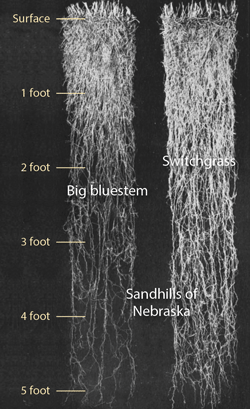The author is a soil scientist with the USDA Agricultural Research Service in Raleigh, N.C.

To have healthy, functioning grasslands that are nutritious as livestock forage, productive over time, resilient in the face of periodic droughts, that resist the erosive action of intense thunderstorms, and that extract nutrients from soil efficiently, these swards need a vigorous root system!
Indeed, productive grasslands are well-rooted in a variety of soils and landscapes. Restrictive layers from high clay content, saturated water conditions, or subsoil acidity can be challenging for some forage species. However, with time, even these difficult soil conditions can be managed for proliferation of deep roots. Silver bullet solutions for obtaining deep rooting may be elusive, but some guiding principles are appropriate.
Roots come in different forms
Most grass roots proliferate near the soil surface because this is where nutrients are concentrated and in plant-available forms from decomposition of soil organic matter; it’s also where fertilizers are often applied. Rainfall that more frequently wets the soil surface than it does the subsoil may be another reason for dominance of roots near the soil surface. More ideal oxygen levels are also present near the soil surface.
Legumes and many forbs tend to have thicker taproots to search for water deeper in the profile, but with a significant number of lateral branches to explore near the surface, too. Taproots may be able to compete better than fibrous roots for water and nutrients deeper in the soil profile.
Extracting water deep in the soil profile can lead to days and weeks of more available forage when growth is prolific and summer winds start drying out the upper profile. Deep roots provide a steady conduit of water to keep forages actively growing and able to withstand drought. Soils are healthier when roots can proliferate to extract water and nutrients while depositing carbon throughout the soil profile.
How grasslands are managed can alter the extent of rooting depth. Usefully, the extent of forage mass above ground is a reflection of the rooting mass below ground. Therefore, tall forage stands that have been deferred from grazing can be envisioned to have deeper rooting systems than short forage stands that have been continuously grazed. More precisely, greater rooting density near the soil surface mirrors that of greater density of forage per inch of height from the soil surface.
Rotational stocking to create variably tall and short forage stands over time may be a relatively simple way to encourage deep rooting while also harvesting the nutritive value of forages with livestock consumption. Lengthy intervals between hay cuttings may achieve similar deep rooting, although nutrients are being removed rather than returned to the same land via livestock excrement.

What about soil carbon?
A common perception is that deep rooting leads to deep soil carbon accumulation. Research on this topic is underway. At least in the warm and moist conditions of the southeastern U.S., significant accumulation of carbon deep in the profile may not be as likely as often hypothesized.
Accumulation of soil carbon is dependent on the net balance between carbon inputs from surface residues, sloughed or dying roots, and decomposition of carbon from soil microorganisms that feed on these carbon inputs. High carbon inputs can be negated with high soil microbial activity.
This article appeared in the April/May 2023 issue of Hay & Forage Grower on page 12.
Not a subscriber? Click to get the print magazine.

